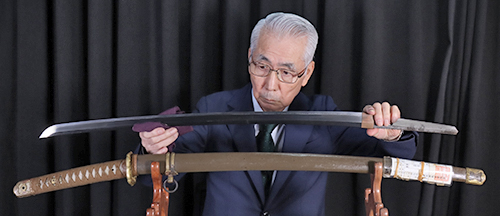Description
Ordering number:AS23411
Katana in Koshirae
Signature: Nagamitsu
長光
We divide 4 sections for each sword as Saijyo Saku, Jyojyo Saku, Jyo Saku and Regular Saku.
This blade is ranked as Jyo Saku among the works of Nagamitsu.
Habaki: Plain copper habaki
Blade Length: 69.3 cm (27.28 in)
Curvature: 1.8 cm (0.71 in)
Mekugi Hole: 1
Width at Base (Motohaba): 3.32 cm (1.31 in)
Width at Tip (Sakihaba): 2.36 cm (0.93 in)
Thickness of rim (Kasane): 0.75 cm (0.30 in)
Sword Weight: 810 g
Era: Showa period, wartime (1930s–1940s)
Shape: Longer than usual for Nagamitsu at 69.3 cm.
Wide blade, thick kasane, with deep curvature and extended kissaki.
There is about 4 cm of ubuha, making this a healthy blade.
Jigane: Well-forged ko-itame-hada, resulting in a fine surface.
Hamon: Nie-deki with small gunome-midare running continuously from hamachi to kissaki.
Boshi is midare-komi.
Features: This work is attributed to Nagamitsu (Ichiryushi).
Based on the nakago style, it is regarded as a well-made Showa-era blade.
During wartime, Shigetaro Emura, the warden of Okayama Prison, promoted sword-making as part of prisoner rehabilitation.
He invited Ichiryushi Nagamitsu, a local swordsmith, to instruct prisoners in sword production.
Nagamitsu was an officially appointed Rikugun Jumei Tosho and was known in the area, even selected for the Rikugun Gunto Gijutsu Shoreikai.
Since prisoners made many blades under his supervision, the workmanship varied and polish was often insufficient.
Some may appear crude, but when properly polished, they reveal fine jigane and occasionally outstanding craftsmanship.
Signatures vary from simply “Nagamitsu,” to “Ichiryushi Saku,” “Ichiryushi Nagamitsu,” and “Bizen Kuni Oju Ujo Shita Ichiryushi Nagamitsu Saku.”
Koshirae: Imperial Japanese Army Gunto Koshirae.
Aoi Art’s Comment: Nagamitsu is famous as the swordsmith who taught prisoners at Okayama Prison during wartime at the request of the prison officers.
He produced a large number of blades, including many excellent works, some approaching the level of Shinshinto masterpieces.
This blade shows gunome-chōji-midare with well-formed ashi, and the ha is bright and clear.
Both Nagamitsu and Emura have strong popularity among collectors, and this is a promising piece.
Historical Background: During World War II, large numbers of Japanese swords were produced.
This example, unusually long at 69.3 cm for an army gunto, is well-polished and therefore a valuable piece.
It was likely made for a taller soldier.
Since it has already been polished, it can be enjoyed as a display sword.
Aoi Art estimation paper with whole oshigata
Overseas shipping charged additionally









 日本語
日本語






